Hyundai Tucson vs Renault Clio - Differences and prices compared
Costs and Efficiency:
Price and efficiency are key factors when choosing a car – and this is often where the real differences emerge.
Renault Clio has a decisively advantage in terms of price – it starts at 16600 £, while the Hyundai Tucson costs 30600 £. That’s a price difference of around 14049 £.
Fuel consumption also shows a difference: Hyundai Tucson manages with 1 L and is therefore decisively more efficient than the Renault Clio with 4.10 L. The difference is about 3.10 L per 100 km.
Engine and Performance:
Power, torque and acceleration say a lot about how a car feels on the road. This is where you see which model delivers more driving dynamics.
When it comes to engine power, the Hyundai Tucson has a noticeable edge – offering 252 HP compared to 158 HP. That’s roughly 94 HP more horsepower.
In acceleration from 0 to 100 km/h, the Hyundai Tucson is barely noticeable quicker – completing the sprint in 7.90 s, while the Renault Clio takes 8.30 s. That’s about 0.40 s faster.
In terms of top speed, the Hyundai Tucson performs a bit better – reaching 204 km/h, while the Renault Clio tops out at 180 km/h. The difference is around 24 km/h.
There’s also a difference in torque: Hyundai Tucson pulls decisively stronger with 379 Nm compared to 205 Nm. That’s about 174 Nm difference.
Space and Everyday Use:
Whether family car or daily driver – which one offers more room, flexibility and comfort?
Seats: offers more seating capacity – vs .
In curb weight, Renault Clio is noticeable lighter – 1124 kg compared to 1542 kg. The difference is around 418 kg.
In terms of boot space, the Hyundai Tucson offers clearly perceptible more room – 620 L compared to 391 L. That’s a difference of about 229 L.
In maximum load capacity, the Hyundai Tucson performs evident better – up to 1799 L, which is about 623 L more than the Renault Clio.
When it comes to payload, Hyundai Tucson slightly takes the win – 545 kg compared to 463 kg. That’s a difference of about 82 kg.
Who comes out on top?
Overall, the Hyundai Tucson shows itself to be wins the duel decisively and secures the title of DriveDuel Champion.
It convinces with the more balanced overall package and proves to be the more versatile choice for everyday use.
 @ Hyundai Motor Company
@ Hyundai Motor Company
Hyundai Tucson
Costs and Consumption
View detailed analysis
Engine and Performance
View detailed analysis
Dimensions and Body
View detailed analysis
Hyundai Tucson
Hyundai Tucson marries bold, sculpted looks with a clever, roomy cabin that feels smarter than its price tag suggests. It's composed on the road, easy to live with day-to-day, and a sensible choice for buyers who want SUV style without the showroom theatrics.
details @ Hyundai Motor Company
@ Hyundai Motor Company
 @ Hyundai Motor Company
@ Hyundai Motor Company
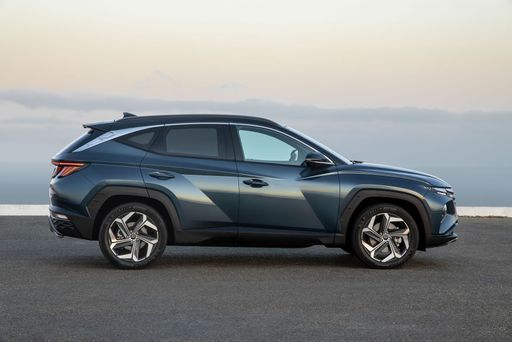 @ Hyundai Motor Company
@ Hyundai Motor Company
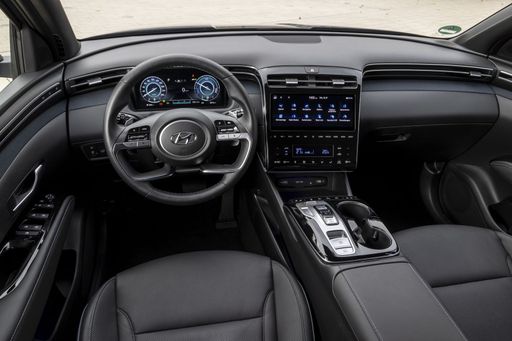 @ Hyundai Motor Company
@ Hyundai Motor Company
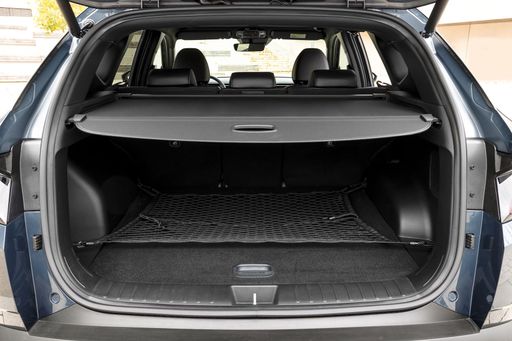 @ Hyundai Motor Company
@ Hyundai Motor Company
Renault Clio
The Clio punches above its weight with chic French styling and a surprisingly grown-up cabin that makes city driving feel effortlessly stylish. It's an easy-to-live-with choice that keeps ownership simple and even manages to put a grin on your face when the traffic gets dull.
details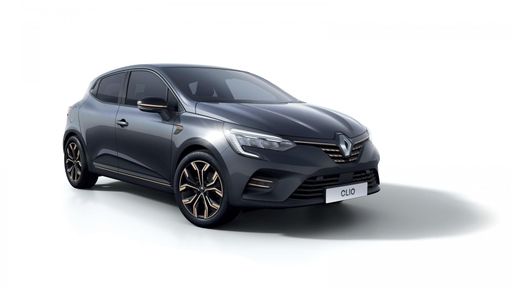 @ Renault Group Media
@ Renault Group Media
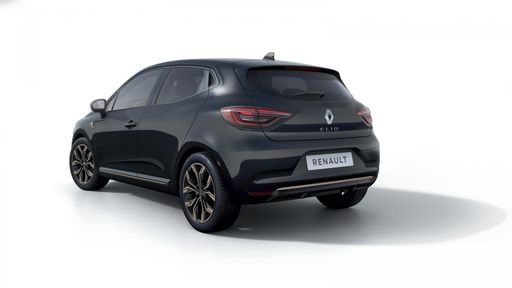 @ Renault Group Media
@ Renault Group Media
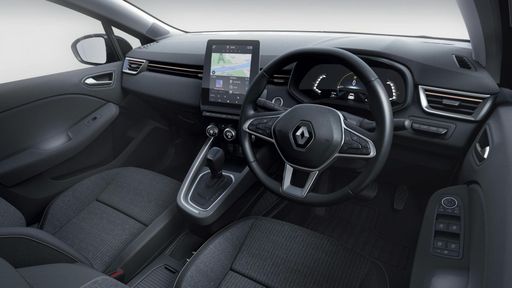 @ Renault Group Media
@ Renault Group Media
 @ Hyundai Motor Company
@ Hyundai Motor Company
|
 @ Renault Group Media
@ Renault Group Media
|
|
|
|
Costs and Consumption |
|
|---|---|
|
Price
30600 - 46300 £
|
Price
16600 - 23700 £
|
|
Consumption L/100km
1 - 7.6 L
|
Consumption L/100km
4.1 - 5.3 L
|
|
Consumption kWh/100km
-
|
Consumption kWh/100km
-
|
|
Electric Range
64 - 70 km
|
Electric Range
-
|
|
Battery Capacity
-
|
Battery Capacity
0.60 kWh
|
|
co2
22 - 172 g/km
|
co2
92 - 121 g/km
|
|
Fuel tank capacity
42 - 54 L
|
Fuel tank capacity
39 - 42 L
|
Dimensions and Body |
|
|---|---|
|
Body Type
SUV
|
Body Type
Hatchback
|
|
Seats
5
|
Seats
5
|
|
Doors
5
|
Doors
5
|
|
Curb weight
1542 - 1889 kg
|
Curb weight
1124 - 1331 kg
|
|
Trunk capacity
546 - 620 L
|
Trunk capacity
301 - 391 L
|
|
Length
4510 - 4535 mm
|
Length
4053 - 4116 mm
|
|
Width
1865 mm
|
Width
1768 - 1798 mm
|
|
Height
1650 mm
|
Height
1440 - 1451 mm
|
|
Max trunk capacity
1721 - 1799 L
|
Max trunk capacity
979 - 1176 L
|
|
Payload
523 - 545 kg
|
Payload
398 - 463 kg
|
Engine and Performance |
|
|---|---|
|
Engine Type
Diesel MHEV, Plugin Hybrid, Petrol, Full Hybrid
|
Engine Type
Full Hybrid, Petrol
|
|
Transmission
Automatic, Manuel
|
Transmission
Automatic, Manuel
|
|
Transmission Detail
Dual-Clutch Automatic, Automatic Gearbox, Manual Gearbox
|
Transmission Detail
Automatic Gearbox, Manual Gearbox, Dual-Clutch Automatic
|
|
Drive Type
Front-Wheel Drive, All-Wheel Drive
|
Drive Type
Front-Wheel Drive
|
|
Power HP
136 - 252 HP
|
Power HP
67 - 158 HP
|
|
Acceleration 0-100km/h
7.9 - 11.6 s
|
Acceleration 0-100km/h
8.3 - 17.1 s
|
|
Max Speed
180 - 204 km/h
|
Max Speed
160 - 180 km/h
|
|
Torque
250 - 379 Nm
|
Torque
95 - 205 Nm
|
|
Number of Cylinders
4
|
Number of Cylinders
3 - 4
|
|
Power kW
100 - 185 kW
|
Power kW
49 - 116 kW
|
|
Engine capacity
1598 cm3
|
Engine capacity
999 - 1789 cm3
|
General |
|
|---|---|
|
Model Year
2024 - 2025
|
Model Year
2023 - 2026
|
|
CO2 Efficiency Class
E, B, F, D
|
CO2 Efficiency Class
C, D, B
|
|
Brand
Hyundai
|
Brand
Renault
|
What drive types are available for the Hyundai Tucson?
Available configurations include Front-Wheel Drive or All-Wheel Drive.
The prices and data displayed are estimates based on German list prices and may vary by country. This information is not legally binding.
